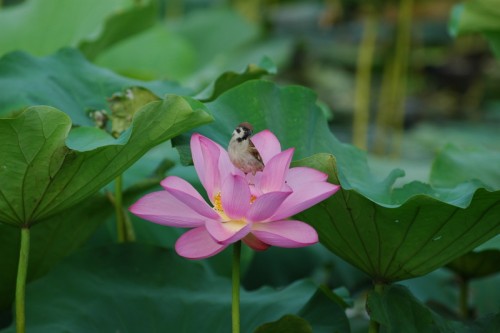TELDAP Collections
| Lotus, Lotus, When Do You Bloom? — A Telltale Sign of Summer |
|
People love to personify the natural world. For instance, in Chinese culture the plum blossom, orchid, bamboo, and chrysanthemum represent four gentlemen of humble and noble character. The mudan (peony), apart from symbolizing affluence and honor, can also be used to describe an beautiful woman. Finally, a blade of grass that shoots from a crack in the asphalt ground is often interpreted as an indicator of dogged perseverance. As chilly spring is replaced by scorching summer, the lotus, which blooms in June, features prominently in a variety of excellent, cooling summer dishes. It is also depicted in The Ode to the Lotus Flower written by Zhou Dunyi in the Song Dynasty as a person whose “clear fragrance reaches far, and fair, graceful figure stands tall in the water.”
The lotus (Nelumbo nucifera), also known as the water lily, is an herbaceous perennial of the Nelumbo genus and Nelumbonaceae family. Every part of the lotus is edible and widely used for both culinary and medicinal purposes in Asia. According to the Compendium of Materia Medica, the root is called, “ou,” the seed, “lianzi,” and the stem and leaf “he” (pronounced huh). It is indicated that lotus root, lotus seeds, lotus petals, lotus seed cups, lotus leaves, and lotus germ are all excellent cooking ingredients. In traditional Chinese medicine, lotus leaves are believed to soothe the heart and lungs. Modern medical research also shows that they can lower blood lipid and cholesterol levels. Rice takes on a delicate fragrance if it is wrapped in crest-shaped lotus leaves and steamed. Hollow lotus stems can clear heat (a traditional Chinese medicine concept), and taste fresh and crunchy when lightly stir-fried. Lotus roots, in addition to also having heat-clearing properties, are excellent for fortifying the blood. Sweetened lotus root makes a delectable dessert. As for lotus seeds, their calming and nourishing properties make them a popular ingredient in dessert making. Even the petals of lotus flowers can be used to brew fragrant tea that helps one combat aging and stay fit. In addition to its culinary uses, the lotus is one of the favorite subjects of Chinese painters and poets. Photographers also love to capture their likeness. Moreover, as the Chinese word for “lotus” sounds the same as that for “harmony,” the plant has become a symbol for “harmonious union forever.”
The graceful lotus is a favorite with painters. This is a painting by Huang Leisheng (1928- ).
(Photo sourced from and archived at the National Museum of History)
The mention of harmonious union calls to mind the Two Immortals of Harmony and Union which frequently appear in traditional Chinese woodcut printing. With a blooming lotus and a round box in their hands, the Two Immortals symbolize union and completion. The Two Immortals of Harmony and Union evolved from two real-life figures from the Tang Dynasty. Both were monks: one was Han Shan; the other was Shi De. Their brotherly love led to their apotheosis as the gods of harmony and friendship, and even of marital happiness. As time went by, images of the Two Immortals became more varied, appearing not only as old men but sometimes as young children as well. As this instance shows, the lotus is not just a telltale sign of summer; its beauty can be appreciated even in everyday life.
 A woodcut print for newlyweds. In this print are two children: one with a lotus and the other with a jewelry box. A pun is made on the Chinese words for “lotus,” “box,” “harmony” and “union”—all which have the same pronunciation. The inscription on the left indicates the purpose of the image (harmonious union forever).
(Photo sourced from and archived in the National Museum of History)
A great number of things are associated with summer: oppressive heat, cooling woven rush mats, reclining dogs with tongues lolling, shimmering hot asphalt roads, and of course, blooming lotus flowers. Generally speaking, summer anywhere is unbearably hot, but Taiwan is all the more so due to its subtropical climate. Irritable people can find the season just fans the flames. If they are in search of a calming escape, they may find the key after tasting a few healthy lotus delicacies.
A scene from the lotus pond at the Taipei Botanical Garden. A sparrow also comes seeking shade.
(Photo courtesy of Mr. Xu Zehui)
References:
Lin Chunji. (2009). Aquatic and Wetland Plants of Taiwan. Vol. 1. Taipei City: Commonwealth.
Zhou Yucang, & Zhou Yugan (Eds.). (2009). Lotus Matters: The Lotus Culture in China. Jinan City, China: Shandong Pictorial Publishing House.
Chen Zengzhi. (Ed.). (2008). 50 Stories about Medicinal Plants. Taipei City: Qilin Culture.
|














